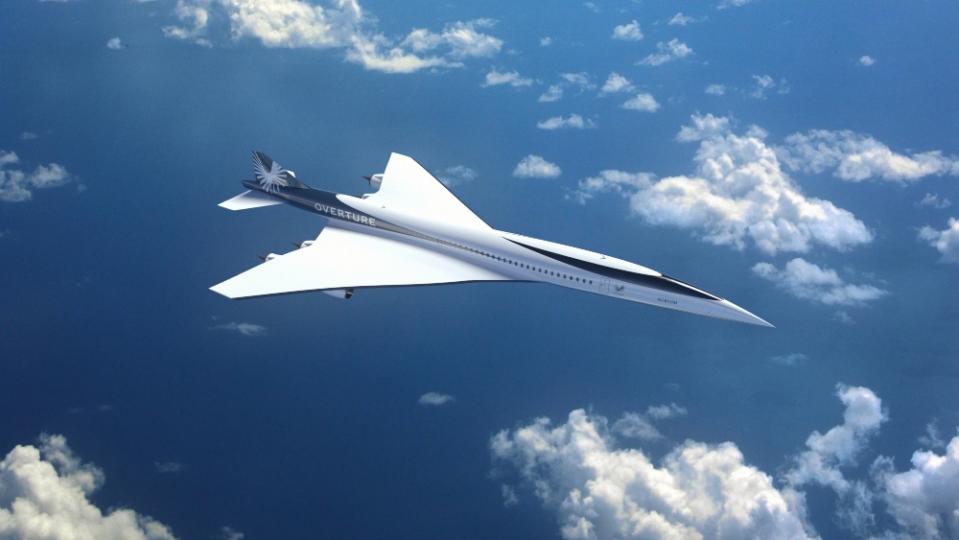Boom’s Supersonic Jet Could Take Off by the End of This Year, CEO Says

After seven years in development, Boom Supersonic is moving closer to flying faster than the speed of sound. The company’s XB-1 experimental prototype is nearing the final stages of ground testing and on track to complete its first test flight by the end of the year, according to an interview with founder and CEO Blake Scholl.
Supersonic flight has the potential to revolutionize travel, shaving hours off the length of a trip. The XB-1 will demonstrate the technology that will inform the Overture, the company’s commercial supersonic jet readying for trans-oceanic travel in 2029. Scholl says the time supersonic travel saves could potentially give tens of millions of passengers the flexibility to ski in St. Moritz instead of Aspen or vacation in Sydney instead of Hawaii.
More from Robb Report
Watch: Boom's Sleek New Supersonic Jet Is One Step Closer to Hitting the Skies
Lego's New 2,000-Piece Concorde Supersonic Jet Set Comes With Retractable Landing Gear
“I believe in a future where more people go more places,” says Scholl, who held positions at Groupon and Amazon before founding Boom in 2014. “Think about crossing the Atlantic in under four hours, leaving the East Coast in the morning, and making it to a dinner meeting in Europe on the same day. Think about being able to do a roundtrip to Asia in 24 hours.”

Earlier this year, Boom began taxi tests for the XB-1 in the Mojave Desert, and recently received an airworthiness certificate from the Federal Aviation Administration (FAA), which legally authorizes the craft for experimental flight. Though closer to becoming airborne, Boom forecasted the XB-1’s first flight several years ago. Scholl says the delays were due to improvements to the engine and “significantly upgrading” the landing gear.
Though cars, phones, and other consumer technology has improved exponentially, commercial aerospace has not fundamentally changed since the 1960s. Supersonic flight has been slow to take off again following the 2003 retirement of the Concorde, which halved the time to travel between New York and London by cruising at twice the speed of sound, due to its high costs, emissions, and noise pollution.
Supersonic overland flight has been banned for decades due to the noise produced when aircraft break the sound barrier. The sonic boom generates shock waves for miles away, rattling windows, tripping car alarms, and wreaking environmental havoc.
Boom says it has received 130 pre-orders and orders from United Airlines, American Airlines, and Japan Airlines for the Overture, which will be built at the company’s factory in Greensboro, N.C. Overture is designed to fly at Mach 1.7 over water—just a hair slower than the Concorde—and run on any blend of jet fuel, including sustainable aviation fuel (SAF).
The XB-1 shares with the Overture certain supersonic design principles and the use of materials such as carbon composites. Both aircraft are shaped to optimize aerodynamics and performance at supersonic speeds. The smaller, needle-nosed XB-1 differs dramatically from the Overture’s design, which features a large front cabin that tapers toward the rear.

But the two aircraft will have very little in common other than the ability to cross Mach 1. The XB-1 will be flown by a lone pilot, while the Overture’s dimensions will allow for multiple crew, between 64 and 80 business-class seats, and a boarding area with eight-foot cathedral ceilings, Scholl said. The front cabin will feature two seats on either side of the aisle, while the narrower back cabin will have one seat on either side. The last row measures roughly the width of Gulfstream’s 18-passenger G650 business jet.
Last year, when Rolls-Royce pulled out of a project to develop an engine for the Overture, Boom launched an effort to develop its own engine, called Symphony, with three partners, including Florida Turbine Technologies (FTT) for engine design and initial production, GE Additive for additive technology design consulting, and StandardAero for maintenance.
The announcement produced some skepticism among aviation analysts that the Overture would ever take off. “Designing an engine is no easy task, especially from scratch, and it’s potentially a multibillion-dollar exercise beyond designing the plane,” Brian Foley, an aviation analyst, tells Robb Report. “Much of the public, and even some in our industry, don’t appreciate the substantial dollars that will be required to get this thing over the top.”

The single-cockpit XB-1, which gained the nickname “Baby Boom,” is a much simpler design. It will be powered by three proven General Electric J85-15 engines that provide more than 12,000 pounds of thrust. Before taking flight, the demonstrator aircraft will undergo more taxi testing, gradually increasing its runway speed.
Boom is one of a handful of start-ups undertaking supersonic flight. Spike Aerospace in Boston is developing a supersonic corporate jet. In 2021, Aerion Supersonic folded citing challenges raising capital.
NASA and Lockheed Martin are also working on an experimental supersonic jet, the X-59, that cuts the sonic boom from roughly 105 decibels—the sound of a clap of thunder—to 75 decibels, akin to the whir of a vacuum cleaner or the slam of a car door 20 feet away. The prototype, which features a long, narrow design that reduces and redistributes shock waves, is scheduled for its first test flight later this year.
Best of Robb Report
Sign up for Robb Report's Newsletter. For the latest news, follow us on Facebook, Twitter, and Instagram.

